Back in the USSR
 First published in Design Week, January 1987
First published in Design Week, January 1987As a centenary show at the Royal Academy of Art revives British interest in the design output of Russia after 1917, this review of SO Khan-Magomedov, Rodchenko: the complete work (Thames and Hudson, 1986) looks at one of the founding fathers of Soviet design
The cover shows Rodchenko’s England and France, 1920
Working at the international designers Fitch in London 1986, we found ourselves telling quite a few clients to look out for blacks and reds in 1987. We argued that, in the seventieth year after the Russian Revolution, Constructivist motifs would be set for comeback. This would not only be because of the favour they enjoy with graphics stars like David King and Neville Brody; nor even because, in their economy of colour, they still allow print costs to be controlled with ease. No, we argued that a liberal marketing man like Mikhail Gorbachev would, in 1987, want to give the West a thorough course in the idiosyncratic achievements of his state’s founder artists and designers.
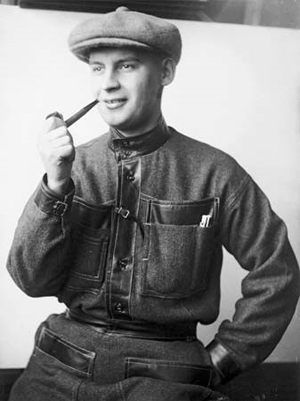 If this book is anything to go by, we were wrong. Christopher Hogg, chief of the Courtauld textile empire, has alerted his designers to Constructivism; last year’s Paris fashions were full of it; in Soho’s Old Compton Street, there are two whole corner shops full of hammer-and‑sickle tee-shirts, Red Star badges and all the rest. But a fad among Western imitators is not the same as being offered, from the country of origin, a comprehensive and in‑depth catalogue of the genuine article. Indeed the signals sent out by Khan-Magomedov, a top Soviet historian of art and architecture and main contributor to this book, suggest that we can expect from the Kremlin, at best, a glossy travesty.
If this book is anything to go by, we were wrong. Christopher Hogg, chief of the Courtauld textile empire, has alerted his designers to Constructivism; last year’s Paris fashions were full of it; in Soho’s Old Compton Street, there are two whole corner shops full of hammer-and‑sickle tee-shirts, Red Star badges and all the rest. But a fad among Western imitators is not the same as being offered, from the country of origin, a comprehensive and in‑depth catalogue of the genuine article. Indeed the signals sent out by Khan-Magomedov, a top Soviet historian of art and architecture and main contributor to this book, suggest that we can expect from the Kremlin, at best, a glossy travesty.
This is an often beautiful but largely scandalous work. Beautiful, because Alexander Rodchenko (1891‑1956) is, with El Lizzitsky, one of the most prolific designers of this century. Scandalous, because despite the title, what is presented here is far from Rodchenko’s complete work. Although some of it has not been seen before, and the range of 2D and 3D artefacts covered does justice to Rodchenko’s extraordinarily wide‑ranging talent, the omissions are shocking.
The pictures, and the words that accompany them, also reveal a lot. Since Camilla Grey’s pioneering work, The great experiment: Russian art 1863-1922(1962), there has been a revival of Western interest inRodchenko, Tatlin, the Suprematist Malevich and the general art and design of the Russian Revolution. Beginning with the Oxford Museum of Modern Art’s Rodchenko show, places as diverse as Eindhoven, Montreal, the Pompidou Centre, Los Angeles, the Smithsonian, the Royal Academy and the Crafts Council have held exhibitions and sold books about the Russians. It is thus not difficult to spot what is missing from this 300‑page tome.
One of Rodchenko’s best montages (1923) depicts Leon Trotsky, the leader of the Red Army, orating atop his mobile train HQ, arms outstretched, surrounded by wide‑winged aeroplanes (one of which he resembles) and an airship. One of Rodchenko’s worst photographs (1938), which appeared as a book cover, is of Red Army soldiers watched over by Uncle Joe Stalin.
Neither image appears in any of the labyrinthine layouts before us.
Rodchenko’s trajectory from independent creator to reluctant apologist for Stalin’s terrorist industrialisation of the USSR is not alluded to in the text. Indeed our Soviet guide gives October 1917 and the ensuing events barely a mention. Nor do we learn of Stalin’s 1932 decree on the ‘reconstruction’ of literary and artistic assocations, which substituted vulgar socialist realism for what, since his political triumph in 1924, had been derided as ‘formalism’.
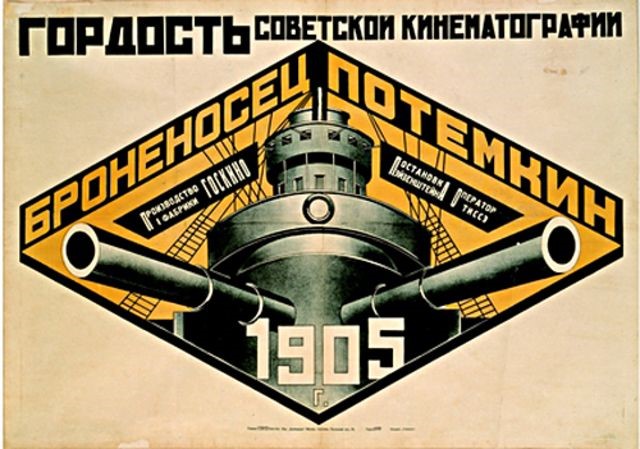
Poster for Sergei Eisenstein’s Battleship Potemkin, 1925-26
Were Moscow’s newly acquired media energies today exercised in mounting a serious celebration of
the Constructivist legacy, we could, as designers, begin to measure Rodchenko’s dazzling shifts of interest against the political turbulence of his times. A student from bourgeois Kazan, Rodchenko went from Art Nouveau pen drawings and gouaches (1910-13) to Chinese curios and Cubism (1914‑15). In the year of the October Revolution he experimented with formalism, futurism and geometry, going on in 1918 to devise concept studies for light fittings, as well as his own system of colour and texture. In the time of civil war and famine it was linocuts, linearism, collage, newspaper kiosks, architecture, fashion and sculptural studies in wood and metal. Having observed in 1919 that the crushing of all ‘isms’ in painting was his ‘resurrection’, Rodchenko was one of the fine artists who backed Ossip Brik’s 24 November 1921 nmatuicsto. calling for an end to easel painting and a move into volume design.
Throughout the era of the New Economic Policy (1921‑3), Rodchenko tried to defend the state against the multiplying forces of private capitalism in Russia, turniughis atl.cld.inn W advertisements, books, magazines, tableware, furniture, exhibition and leisure design. and ending, between1927 and the inauguration of Stalin’s first Five year Plan in 1929, with a series of theatre and film sets.
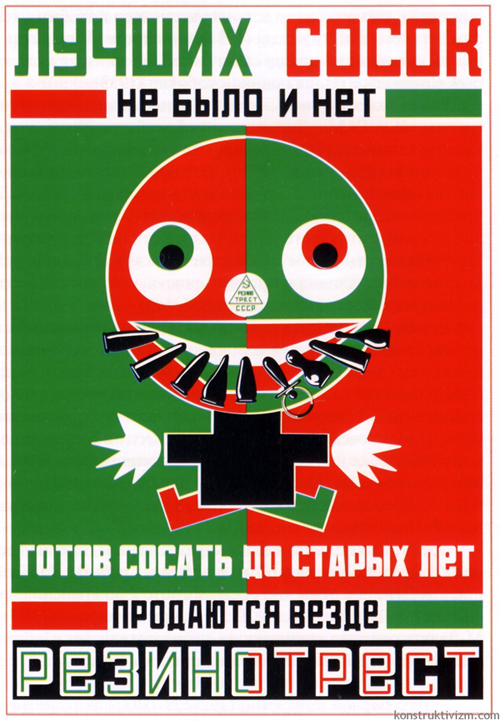
‘None better’, poster for rubber dummies for babies, 1923
After that, despite some fine photographs and a bittersweet return to fine art, Rodchenko was effectively a broken man. But we do not hear why, and we are unlikely ever tohear from our friend Gorbachev. Even the most zealous Soviet reformer cannot bear to dwell toolong on the fate of the Constructivists under Stalinism. Mayakovsky, copywriter to Rodchenko’s images, killed himself in 1930; Klucis, designer of those bizarre loudspeaker rostrums‑cum-newsstands and a supporter of Trostky’s Left Opposition, was eliminated in the purges of 1938; Meyerhold, the father of Soviet theatre and a collaborator of Rodchenko’s, was denounced by Vyshinky, chief prosecutor at the Moscow Trials, and died in 1940.
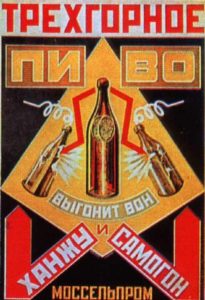
Poster for Mosselprom beer
The charm of ancient Greek art, wrote Karl Marx once, lay in its naiveté, in the fact that it was enormously advanced given the unripe social conditions under which it arose – conditions which, the old man contended, could never return. It is the same with Soviet design. Nothing could be more foolish than to try to recreate, in a contemporary British context, the limited production runs and vibrant aesthetics of the heroic epoch of Soviet design.
Showing the Burton Group some Constructivism recently, Fitch’s Mark Landini, famous for his work for Midland Bank, held that these were exactly the forms and hues not to hawk in 1987. But a decent history, not to say a documentary movie, of Rodchenko and his times: that will be worth waiting for.
Fmr President of Kenya on Trump cutting off foreign aid:
“Why are you crying? It’s not your government, he has no reason to give you anything. This is a wakeup call to say what are we going to do to help ourselves?”
America first is good for the world.
Our entire Green Socialist establishment should be banged up under the ‘Online Safety’ laws, for spreading demonstrable lies (the ‘climate crisis’), causing non-trivial harm to the industrial working class, ordinary drivers, farmers, taxpayers etc, etc.
#Chagos? #Mauritius PM Navin Ramgoolam "is reported to want Starmer to pay £800m a year, plus ‘billions of pounds in #reparations’." (14 January) https://www.spiked-online.com/2025/01/14/the-chagos-islands-deal-is-an-embarrassment/
Now the Torygraph wakes up https://telegraph.co.uk/gift/1ff8abbb462cd609
Read @spikedonline - first with the news!
Articles grouped by Tag
Bookmarks
Innovators I like

Robert Furchgott – discovered that nitric oxide transmits signals within the human body

Barry Marshall – showed that the bacterium Helicobacter pylori is the cause of most peptic ulcers, reversing decades of medical doctrine holding that ulcers were caused by stress, spicy foods, and too much acid

N Joseph Woodland – co-inventor of the barcode

Jocelyn Bell Burnell – she discovered the first radio pulsars

John Tyndall – the man who worked out why the sky was blue

Rosalind Franklin co-discovered the structure of DNA, with Crick and Watson

Rosalyn Sussman Yallow – development of radioimmunoassay (RIA), a method of quantifying minute amounts of biological substances in the body

Jonas Salk – discovery and development of the first successful polio vaccine

John Waterlow – discovered that lack of body potassium causes altitude sickness. First experiment: on himself

Werner Forssmann – the first man to insert a catheter into a human heart: his own

Bruce Bayer – scientist with Kodak whose invention of a colour filter array enabled digital imaging sensors to capture colour

Yuri Gagarin – first man in space. My piece of fandom: http://www.spiked-online.com/newsite/article/10421

Sir Godfrey Hounsfield – inventor, with Robert Ledley, of the CAT scanner

Martin Cooper – inventor of the mobile phone

George Devol – 'father of robotics’ who helped to revolutionise carmaking

Thomas Tuohy – Windscale manager who doused the flames of the 1957 fire

Eugene Polley – TV remote controls

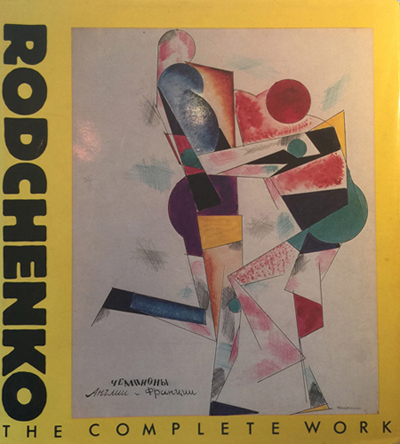

0 comments